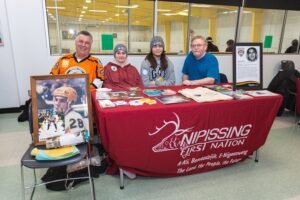CWF WILD Outside program now available to more Indigenous communities

By David DeRocco
KANATA – At the heart of Canada’s Indigenous communities is a deep connection to the land and a respect for the wildlife that inhabit it. Engaging Indigenous youth in the ongoing stewardship of such wild spaces is a vital step toward ensuring a bright future for nature in communities across the country.
That’s where Dan Frawley and his colleagues at the Canadian Wildlife Federation (CWF) come in. As part of its conservation education programming, CWF is now offering its award-winning WILD Outside program to Indigenous youth in remote and rural communities. WILD Outside is a national conservation-based community service and leadership program designed for youth ages 15 to 18 and funded in part by the Government of Canada through its Canada Service Corps program. It launched in 2020 in urban communities with a goal of inspiring youth participants to develop their passion for service through conservation activities, build awareness of their natural environment, and inspire a deeper appreciation for wildlife. It’s a program perfectly suited to helping Indigenous youth enjoy fun, adventure, and a nature connection without having to incur any costs for equipment, supplies, and training.
“The kids in these communities have a connection with the land, but a lot of the time you need an adult to step up and organize some of these activities for them,” said Frawley, an Ojibwe from Nipissing First Nation and former NHL player with Chicago and Pittsburgh now serving as CWF’s Support Specialist for Indigenous Inclusion. “Our volunteer Indigenous leaders will be able to design programs that cater to the specific interests and conservation needs of the community. Once we get these programs set up, we can engage kids in all kinds of activities. That’s what helps get the kids out.”
As a member of the Indigenous NHL Alumni Team, Frawley often travelled across Canada visiting Indigenous communities, playing hockey, meeting with youth, and networking with the communities. What he noticed was a growing need for programs like WILD Outside, which is now available for youth of all cultures and abilities in 26 communities across Canada.
“In my travels, I have seen a need for more activities for kids, especially for the more remote communities,” said Frawley, who along with Indigenous former NHL’ers like Ted Nolan, John Chabot, Bryan Trottier, and Denny Lambert have been instrumental in promoting the value and importance of engaging Indigenous youth in sport and other outdoor activities. “When WILD Outside became available, I was very excited about it. This year at the Little Native Hockey League tournament, I had a chance to visit with several communities to discuss it. We’re in talks to hopefully bring this program to more of these communities.”
Chabot, a former NHL player from the Algonquin community of Kitigan Zibi Anishinabeg First Nation, said the WILD Outside program aligns perfectly with the objectives of First Assist, a charity he founded with his son Kyle. First Assist delivers sustainable programming for youth in remote Indigenous communities throughout the country.
Chabot sees WILD Outside as a way for youth to get reconnected to some of their cultural traditions.
“I think when you look at the northern communities that First Assist goes into, WILD Outside kind of fits in perfectly,” said Chabot, whose NHL experience included both Pittsburgh and Montreal. “As a result of the pandemic and other issues, there has, in some cases, been a disconnect from the traditions. We were in Grassy Narrows First Nation last year and some of the kids had never been fishing. With what Dan does with his program, we thought it would be a great way to get the kids outside. In some ways, it’s a reintroduction and in some ways, it’s a brand-new experience. We know it can be a win-win for all three groups – First Nations, WILD Outside, and the communities.”
WILD Outside has earned multiple awards for its youth-focused conservation education programming. Programs are volunteer-led with a focus on learning and service. While outdoor fun and adventure is a major part of the activities, Frawley said the real impact is found in the service projects the youth develop and deliver on route to a goal of 120 hours of service.
“The service component is very important,” he said. “Youth participants get to do projects that have a positive effect on their community such as spring cleanups, shoreline cleanups, building and planting pollinator gardens, and other activities.”
Frawley said that adult volunteers are supported by CWF in their efforts through a dedicated Youth Leadership Specialist that can provide necessary support, resources, and a comprehensive program booklet that maps out the program. To register as an adult volunteer, or to get your 15 to 18-year-old involved, visit WILDOutside.ca.
CWF is a not-for-profit charitable organization, which also provides opportunity for youth ages 18 to 30 through the Canadian Conservation Corps. This program offers travel and training in various locations across the country. Learn more at CanadianConservationCorps.ca.


